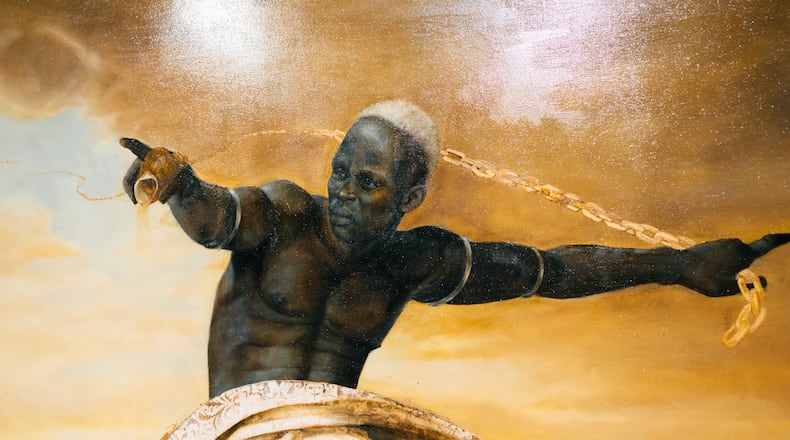Los Angeles artist Harmonia Rosales’ oil paintings on display at the Spelman College Museum of Fine Art are absurdly virtuosic. Like the European Old Masters that inspire them, Rosales’ paintings glow with an otherworldly light. And they render human beings with a transcendent magnificence that makes her work feel like what one can experience in the great museums of the world: contact with the divine.
An artist of Afro-Cuban descent, Rosales in her solo exhibition “Master Narrative” is referencing those Old Masters, but overturning the apple cart of accepted ideas of “mastery.” In her twenty paintings and one installation on view at the Spelman College Museum of Fine Art she is also upending Renaissance painting’s notions of morality, history, heroes and villains.
Credit: Courtesy of Harmonia Rosales/Spelman College Museum of Fine Art
Credit: Courtesy of Harmonia Rosales/Spelman College Museum of Fine Art
In Atlanta for the opening of her traveling exhibition “Master Narrative,” Rosales said, “I believe that there is no master narrative. One, singular master narrative.”
And so, rather than Botticelli’s blonde Venus in “The Birth of Venus,” Rosales offers the stunning painting “The Birth of Oshun” in which a Yoruba deity or “orisha” (which occur throughout the exhibition) is depicted as an imperfect but resplendent goddess whose gleaming Black skin is flocked with gold.
Nodding to the religious paintings of Michelangelo in her own creation stories, Rosales replaces those Christian visions of divinity, grace, beauty and vice with images and ideas drawn from the West African Yoruba religion.
Instead, through her own reimagining of history from a female and African point of view, Rosales said, “I hope to help inspire other artists to really bring their cultural background into a grander conversation for institutions to teach future generations.”
Rosales has some rebirth and regeneration in her own history. Left in financial dire straits with two young children after a divorce, she had to reinvent herself and returned to her long suppressed passion for art. In the wake of that personal devastation, Rosales points out, came something marvelous and transformative. “Bad things happen, but it leads you to your ultimate destiny.”
Credit: Michael Butler Jr
Credit: Michael Butler Jr
Though she’s describing a transcendence in her painting “Still We Rise,” on view at Spelman, she is also touching on her own metamorphosis.
Rosales says she began to create her own work after researching the religious traditions of the Yoruba that had been suppressed during slavery. She wanted to celebrate those beliefs and the Black women she and her young daughters didn’t see in the Renaissance paintings that she saw hanging on museum walls. She thinks that depicting Black people as beautiful and regal in her luminous, captivating oil paintings helped her two daughters, now 13 and 10, grow up with a measure of self-assurance.
At the center of Rosales’ “Master Narrative” is an astoundingly beautiful artwork that took five years to execute. Like Michelangelo’s ceiling of the Sistine Chapel, it is a creation story told in many panels, though here the key players are Black, and Adam and God are depicted as Black women. The paintings are created on the underside of an overturned wooden slave ship that requires viewers to crane their neck to take in the vast cornucopia of imagery.
Credit: Michael Butler Jr
Credit: Michael Butler Jr
Occasionally Rosales veers from images that glorify and ennoble to ones that trade in a more disturbing vision of violence and debasement reminiscent of Kara Walker’s work. In Walker’s unnerving silhouette images slave masters commit unspeakable acts and slaves revolt with justified rage.
In “Still We Rise,” a painting as outrageously detailed and depravity-laden as a Hieronymus Bosch, a slave master cruelly dangles an infant by his tiny wrist and a line of slaves are led away in shackles. A sky full of transcendent Black angels wearing golden halos burn a Confederate flag and escape the violent reality of slavery below on earth. It’s an image of colonizers and enslavers you’d be unlikely to come across in the Louvre or Florence’s Uffizi. Rosales’ work underlines the idea that in most cultural institutions, as they say, “history is written by the victors.”
But Rosales says rather than present her Black subjects as victims, she prefers empowering and glorifying Black people.
“I’m all about the silver lining, but not completely erasing what we’ve gone through. That’s still there, but it’s not the central theme,” she said.
VISUAL ART REVIEW
“Harmonia Rosales: Master Narrative”
Through Dec. 2. Noon-5 p.m. Wednesdays-Saturdays. Suggested donation $5. Spelman College Museum of Fine Art, 350 Spelman Lane SW, Atlanta. 404-270-5607, museum.spelman.edu.
Bottom line: A shockingly beautiful collection of images that are as satisfying to look at as they are subversive in their intent.
About the Author
Keep Reading
The Latest
Featured






